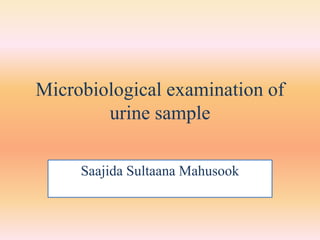
Microbiological examination of urine sample
- 1. Microbiological examination of urine sample Saajida Sultaana Mahusook
- 2. • Urine is the fluid produced by the kidneys that carries water and wastes through the urinary tract and then is eliminated from the body. • Normally, urine in the bladder and the urinary tract from kidney to the last third of the urethra is sterile. • When the urinary tract becomes infected with bacteria, an inflammation at the site of infection results in symptoms of urinary tract infection (UTI), and significant numbers of bacteria and white blood cells (WBC) appear in the urine. • The urine culture is a test that detects and identifies bacteria and yeast in the urine, which may be causing a urinary tract infection (UTI).
- 3. Symptoms of a UTI • A strong, persistent urge to urinate. • A burning sensation when urinating (painful). • Passing frequent, small amounts of urine. • Urine that appears cloudy. • Urine that appears red, bright pink or cola- colored — a sign of blood in the urine.
- 4. Sample Requirement • The genital area is cleaned before collecting your urine • The mid-stream clean catch urine sample is the most common type of sample collected. • Urine may also be collected using a catheter and, rarely, a needle is used to aspirate urine directly from the bladder. • For infants, a collection bag may be attached to the genital area to catch any urine produced. • Urine samples not cultured immediately following collection were refrigerated at 4°C until processing.
- 5. TESTS Drop method • After homogenization of the urine sample, a hanging drop of approximately 50 μl of the urine was deposited, on microscope slide , allowed to dry, without spreading, at ambient temperature. Loop method • A 10-μl volume of homogenized urine sample was applied, by means of a nickel- chrome loop calibrated on microscope slide and was allowed to dry, without spreading, at ambient temperature. Gram staining After air drying, the smears were fixed by passing the slides two or three times through the flame of a Bunsen burner, and then they were stained by Gram method. Microscopic observation • with a 100× oil immersion objective, 50 fields were examined, and the shapes and number of microorganisms and cells per field were recorded. • The microscopic reading was done systematically, beginning at the edge of the central region of the smear and continuing across its diameter. • A positive microscopic examination was defined as the presence of ≥2 microorganisms uniformly distributed per oil immersion field, after observation of at least 20 fields, according to the criteria of Washington et al.
- 6. Microscopic field (oil immersion objective) showing the accumulation of E. coli at the edge of the urine drop (to the left) with the Gram-stained preparation of 10 μl of a positive urine specimen (≥105 CFU/ml). A DIAPLAN microscope (Leitz, Wetzlar, Germany) and Tri-X pan ISO 400/27 film (Eastman Kodak Company, Rochester, N.Y.) were used.
- 7. Semiquantitative urine culture • Semiquantitative urine culture using the calibrated loop technique and inoculation on cystine-lactose-electrolyte-deficient agar (Difco Laboratories, Detroit, Mich.) was employed as the reference method. • Samples were considered positive if they contained ≥105, or 104 to <105, CFU of the urinary pathogen/ml of pure culture. • Also considered to indicate a urinary infection was isolation of two potentially pathogenic bacterial species, when the individual counts for the two species were >105 and >105, >105 and >104, or >104 and >104 CFU/ml, or when the count for one organism was >104 CFU/ml and it was clearly predominant, i.e., at least 10-fold more than the other. • Urine specimens containing ≥105 or <105CFU of nonpathogenic bacteria (lactobacilli, diphtheroids,Staphylococcus epidermidis, or non-group-D Streptococcus spp.)/ml or multiple (three or more) species of gram-negative bacteria, obtained from patients without clinical evidence of urinary infection, were considered contaminated and were excluded from the study. • Isolated microorganisms were identified by standard biochemical procedures.
- 8. The urine culture is used, to diagnose a urinary tract infection (UTI) and to identify the bacteria or yeast causing the infection. If a urine culture is positive, susceptibility testing may be done to determine which antibiotics will inhibit the growth of the microbe causing the infection. The results will help a healthcare practitioner determine which drugs are likely to be most effective in treating your infection. A urine culture is used, to screen pregnant women for asymptomatic bacteriuria, a condition in which significant amounts of bacteria are in the urine but do not cause symptoms. About 2%-10% of pregnant women in the U.S. have this condition that can lead to more serious kidney infection as well as increased risk of preterm delivery and low birth weight.
- 9. FINDING OTHER INFECTIONS • Urine cultures can detect some sexually transmitted diseases but not the test of choice for sexually transmitted diseases in adults. Urine cultures may be used to test for STDs in children. • Some STDs such as chlamydia may be tested using a urine sample, but the testing method used detects chlamydia genetic material in the urine and is not a culture. • For another example, a urine culture may be used to help diagnose infections of the urinary tract and genital tract caused by mycobacteria. Typically, this test requires that the first urine voided in the morning be collected.
- 10. • CREDITS • https://labtestsonline.org/tests/urine-culture • https://pubmed.ncbi.nlm.nih.gov/?term=%22S pecimen+Handling%22%5BMeSH%5D • https://jcm.asm.org/content/36/3/820 • www.mayoclinic.org THANK YOU